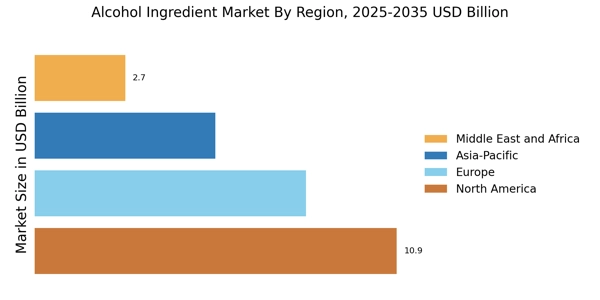Evolving Consumer Preferences
The Alcohol Ingredient Market is witnessing a shift in consumer preferences, with a growing inclination towards unique and diverse flavor profiles. This trend is evident in the rising popularity of flavored spirits and innovative cocktails, which have seen a 40% increase in sales over the past year. Consumers are increasingly adventurous, seeking out new experiences and tastes, which encourages manufacturers to explore unconventional ingredients and combinations. This evolution in preferences not only drives product innovation but also fosters competition among brands to differentiate themselves in a crowded market. As consumer tastes continue to evolve, the Alcohol Ingredient Market is poised for dynamic growth, with opportunities for brands to capture the attention of adventurous drinkers.
Health-Conscious Consumer Trends
The Alcohol Ingredient Market is increasingly influenced by health-conscious consumer trends, as individuals become more aware of the impact of alcohol on their well-being. This awareness has led to a surge in demand for low-calorie and low-sugar alcoholic beverages, with a reported increase of 15% in sales of such products. Additionally, the rise of functional beverages, which incorporate health-promoting ingredients, is reshaping the market landscape. Consumers are now seeking options that align with their health goals, prompting manufacturers to reformulate existing products and introduce new offerings. This shift towards healthier choices is expected to drive innovation within the Alcohol Ingredient Market, as brands strive to create products that appeal to this growing demographic.
Rising Demand for Premium Spirits
The Alcohol Ingredient Market is experiencing a notable increase in demand for premium spirits, driven by consumers' willingness to pay more for high-quality products. This trend is reflected in the growing sales of craft spirits, which have seen a rise of approximately 20% over the past year. As consumers become more discerning, they seek unique flavors and artisanal production methods, prompting manufacturers to innovate with premium ingredients. This shift not only enhances the overall market value but also encourages the development of new products that cater to sophisticated palates. Consequently, the Alcohol Ingredient Market is likely to witness sustained growth as brands invest in high-quality ingredients to meet consumer expectations.
Sustainability and Ethical Sourcing
Sustainability has emerged as a critical driver within the Alcohol Ingredient Market, as consumers increasingly prioritize environmentally friendly practices. The demand for sustainably sourced ingredients is on the rise, with many brands adopting transparent supply chains and eco-friendly production methods. This trend is evidenced by a 25% increase in the use of organic ingredients in alcoholic beverages over the past two years. As consumers become more environmentally conscious, they are more likely to support brands that demonstrate a commitment to sustainability. This shift not only enhances brand loyalty but also encourages innovation in ingredient sourcing and production processes, ultimately benefiting the Alcohol Ingredient Market as a whole.
Technological Advancements in Production
Technological advancements are playing a pivotal role in shaping the Alcohol Ingredient Market, as innovations in production processes enhance efficiency and product quality. The integration of automation and artificial intelligence in manufacturing has led to improved consistency and reduced production costs. For instance, the use of advanced fermentation techniques has resulted in a 30% increase in yield for certain alcoholic beverages. These technological improvements not only streamline operations but also enable producers to experiment with new ingredients and flavors, catering to evolving consumer preferences. As technology continues to advance, the Alcohol Ingredient Market is likely to benefit from increased productivity and the introduction of novel products.


















Leave a Comment